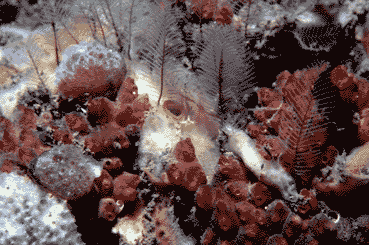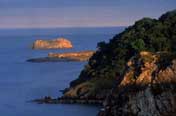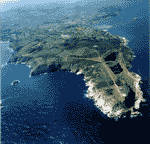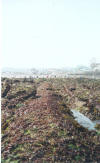 Torbay's
Marine World is a hidden jewel. At Torbay Coast and Countryside Trust we are
trying to unlock the box to reveal this great jewel. The Bay has 16 marine sites
of national importance, including Saltern Cove, designated an underwater Local
Nature Reserve and the only local underwater Site of Special Scientific
Interest. The underwater sites in the Bay range from eel grass beds to fantastic
limestone rock gullies and these habitats host many species, ranging from
cuttlefish (Sepia officinalis), jewel anemones (Corynactis viridis), honeycombe
worms (Sabellaria alveolata) and the Devonshire cup corals (Caryophyllia amithii).
One of the most important discoveries was finding both species of seahorses (Hippocampus
hippocampus and Hippocampus guttulatus) in the Bay. Torbay's
Marine World is a hidden jewel. At Torbay Coast and Countryside Trust we are
trying to unlock the box to reveal this great jewel. The Bay has 16 marine sites
of national importance, including Saltern Cove, designated an underwater Local
Nature Reserve and the only local underwater Site of Special Scientific
Interest. The underwater sites in the Bay range from eel grass beds to fantastic
limestone rock gullies and these habitats host many species, ranging from
cuttlefish (Sepia officinalis), jewel anemones (Corynactis viridis), honeycombe
worms (Sabellaria alveolata) and the Devonshire cup corals (Caryophyllia amithii).
One of the most important discoveries was finding both species of seahorses (Hippocampus
hippocampus and Hippocampus guttulatus) in the Bay.
Through work by volunteers and
by Trust staff, our records are increasing every day and we are slowly starting
to understand the marine environment of our Bay as well as the complexities of
its conservation.
Due south of the centre and at the end of Goodrington beach
you will find Saltern Cove the first underwater local nature reserve (1973).
Saltern Cove is a S.S.S.I. for both marine and geological reasons. Making it a
truly a very special and unique place.
 Along the coast of Torbay there are several biological and geological sites of
special scientific interest (SSSI's), as well as the first underwater nature
reserve to be designated in the British isles way back in 1973. Along the coast of Torbay there are several biological and geological sites of
special scientific interest (SSSI's), as well as the first underwater nature
reserve to be designated in the British isles way back in 1973.
Although records for these sites are present it is vital that
they are maintain and updated in order to be able to monitor changes in species
distribution and the effects of visitor pressure on the different habitats.
 These survey areas include Middle Stone Goodrington Sands and Satlern Cove, with
an 8 year plan currently being devised for the management of the whole of
Torbay’s' marine environment. These survey areas include Middle Stone Goodrington Sands and Satlern Cove, with
an 8 year plan currently being devised for the management of the whole of
Torbay’s' marine environment.
Nigel Smallbones, the trusts coastal zone manger said no
proper records of creatures and habitats at Saltern Cove have been done since
1973 ''Because it is a site of S.S.S.I. and underwater nature research we have
an obligation to produce a management plan.
To find out exactly what is there and what the balance is of
everything. There might not be a problem but if there is we can look at what use
the area and to find a logical solution. The project is expected to capture the
imagination of divers all over Britain as divers from Fast Track - Training will
be mapping and surveying the area. Also they aim to raise awareness among divers
to regard these underwater reefs as part of our heritage.
 As well as a conservation management plan being drawn up all the data will go to
a central recording system linked to Devon Wildlife Trust and the Marine
Conservation Society as part of a huge database on British Isles Marine Habitats
called MERLIN. As well as a conservation management plan being drawn up all the data will go to
a central recording system linked to Devon Wildlife Trust and the Marine
Conservation Society as part of a huge database on British Isles Marine Habitats
called MERLIN.
As you walk along Goodrington Sands towards Saltern Cove, the pebbles and stones
contain some secrets. Many contain fossils of the corals that existed in Torbay
375 million years ago. The seas were much warmer and the Bay had extensive coral
reefs, all to die out, as the ice age advanced. When the ice melted vast forests
covered the area, and at very low tides the 10,000 year old peaty remains can be
found. The Geology of Saltern Cove is very complicated, if you want to know more
and follow geological trail buy the Saltern Cove leaflet from our centre.
 Berry Head
is Torbay's most important wildlife site and one of England's 200 National
Nature Reserves. There are several species of rare and threatened plants growing
at Berry Head, including Early Gentian, White Rock-Rose, Honewort, Small Hare's
Ear, Restharrow and Goldilock's Aster which are dependent upon the thin soils,
mild climate and exposed conditions of the headland. Berry Head
is Torbay's most important wildlife site and one of England's 200 National
Nature Reserves. There are several species of rare and threatened plants growing
at Berry Head, including Early Gentian, White Rock-Rose, Honewort, Small Hare's
Ear, Restharrow and Goldilock's Aster which are dependent upon the thin soils,
mild climate and exposed conditions of the headland.
The patchwork of grassland and scrub which covers most of Berry Head is also
important for small bird species. The Guillemot colony on the cliffs below the
Southern Fort is one of the UK's largest and live CCTV pictures of the colony
from a camera mounted on the cliffs can be seen in the Visitor Centre.
Caves at Berry Head are home to the endangered Greater Horseshoe Bat. Cattle
which have been reintroduced to Berry Head produce cow-pats which in turn
provide food for the bats in the form of dung-beetles!
Two "Napoleonic war" forts dominate the headland, a dramatic reminder both of
Torbay's former military importance and a nation's fear of invasion. Now fully
protected as Scheduled Ancient Monuments, the forts provide the sites strongest
link with the past and a fantastic viewpoint.
|